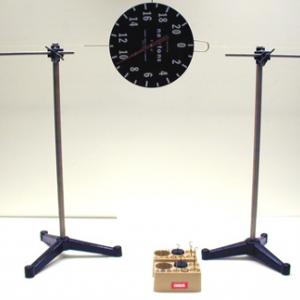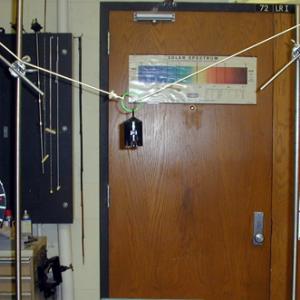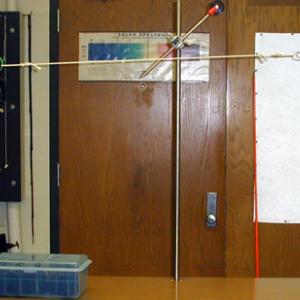College of Liberal Arts & Sciences
1J30.20 - Tension in a String
Lift one mass with the spring scale and show the reading. Stretch the spring scale between two pulleys and add two masses and show the same reading as before.
Another alternative is to use three masses and two strings stretched over pulleys. One mass is in the middle of both strings, the strings are stretched over the pulleys, and the spring scales and masses added to each end of the strings. Observe the readings. Then take the mass off one of the spring scales and attach that scale to a rod or the wall. Transfer that mass to the other spring scale and again observe the readings.
A spring scale hangs between two strings which go over pulleys. Attach a 1 kg mass to each string and observe the scale reading. Then take the mass off of one string and fix the spring scale to a rod or a wall. Transfer and add the mass to the other string. This arrangement should show twice the string tension even though you are using the same components.
A smaller version of a string stretched between two scales with a mass hanging on the string is available using the tension protractors. Note however that each scale only goes to 10 Newtons.
- Paul Hewitt, "Answer to February Figuring Physics", TPT, Vol. 57, #3, Mar. 2019, p. 195.
- Wojciech Dindorf, "A Remarkable Vector Addition Exercise", TPT, Vol. 49, #8, Nov. 2011, p. 517.
- Paul Hewitt, "Figuring Physics", TPT, Vol. 45, #7, Oct. 2007, p. 450.
- Paul Hewitt, "Figuring Physics", TPT, Vol. 42, #8, Nov. 2004, p. 499.
- James O'Connell, "Tension in a Pendulum String", TPT, Vol. 40, #1, Jan. 2002, p. 24.
- "Figuring Physics", TPT, Vol. 36, #1, Jan. 1998, p. 59.
- David Kagan and Michael McGie, "Some Physics of Kite Strings", TPT, Vol. 35, #4, Apr. 1997, p. 202.
- Albert Bartlett, "Calculate the Tension in the Rope", TPT, Vol. 27, #5, May 1989, p. 416.
- Carl T. Rutledge, "Weight vs. Mass - Round II", TPT, Vol. 26, #1, Jan. 1988, p. 9.
- D. Easton, "Counterintuitive" Physics", TPT, Vol. 23, #7, Oct. 1985, p. 423.
- Gary D. Gordon, "Not Such a Hard Bump...?", TPT, Vol. 10, #1, Jan. 1972, p. 6.
- Samuel Derman, "The Wicked King and Beautiful Princes", TPT, Vol. 9, #7, Oct. 1971, p. 387.
- Rod Cross, "Tension Loss Along a String", AJP, Vol. 68, #12, Dec. 2000, p. 1152.
- Ml-1: "Tension in a String", Freier and Anderson, A Demonstration Handbook for Physics.
- M-106: "Weight on Acc. Spring Balance", DICK and RAE Physics Demo Notebook.
- Martin Gardner, "Super - Strength", Entertaining Science Experiments with Everyday Objects, p. 98.
- Julius Sumner Miller, Q90 & A90, Millergrams I – Some Enchanting Questions for Enquiring Minds, p. 59 & 108.
- Julius Sumner Miller, Q196 & A196, Millergrams II – Some More Enchanting Questions for Enquiring Minds, p. 55 & 106.
Disclaimer: These demonstrations are provided only for illustrative use by persons affiliated with The University of Iowa and only under the direction of a trained instructor or physicist. The University of Iowa is not responsible for demonstrations performed by those using their own equipment or who choose to use this reference material for their own purpose. The demonstrations included here are within the public domain and can be found in materials contained in libraries, bookstores, and through electronic sources. Performing all or any portion of any of these demonstrations, with or without revisions not depicted here entails inherent risks. These risks include, without limitation, bodily injury (and possibly death), including risks to health that may be temporary or permanent and that may exacerbate a pre-existing medical condition; and property loss or damage. Anyone performing any part of these demonstrations, even with revisions, knowingly and voluntarily assumes all risks associated with them.



